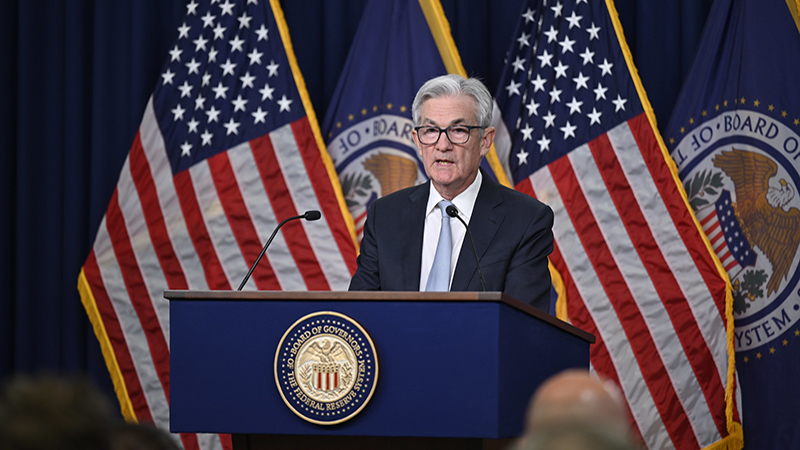Federal Reserve chair Jerome Powell hinted the pace of interest rate rises may slow starting with the next Federal Open Market Committee (FOMC) meeting on 13 December.
In a speech to economic research group the Brookings Institution, he said that while the battle to bring inflation down to its 2% target was “far from over”, it “makes sense to moderate the pace of our rate increases as we approach the level of restraint that will be sufficient to bring inflation down”.
“The time for moderating the pace of rate increases may come as soon as the December meeting,” he added.
Following the speech, industry commentators are expecting a slightly more dovish 50bps increase after the Fed raised rates by 75bps at each of the last four meetings.
There was some discord over the significance of any slowing of interest rate hikes, with Janus Henderson global bonds portfolio manager Jason England suggesting that eyes should be on when rate rises as a whole will pause, rather than the slowing pace of the hikes.
He said: “The focus now should not be on the pace, but how much higher rates will need to go and how long they will need to stay there. As the Fed will need to see ‘substantially more evidence’ that inflation is easing before they pause and Powell ended his speech by saying ‘history cautions strongly against prematurely loosening policy’, so pricing in cuts is premature as well. The market is taking this as dovish, however his speech does not change our view that the Fed still has work to do and will continue to push rates higher, albeit at a slower pace, to a terminal rate of around 5%.”
Twenty Four AM portfolio manager George Curtis said, while Powell’s acknowledgement that inflation was starting to soften caused markets to rally, caution is still needed as the Fed looks to “keep financial conditions tight and policy highly restrictive”.
Curtis added: “The Fed has not won the war on inflation by any means, but we believe the trend over the next six-to-12 months will continue to show a decline in the inflationary pressures seen post-pandemic. When inflation rolls over is ultimately less important than where it ends up, so the Fed will remain highly data-dependent, and will most likely want to make sure the market does not get ‘ahead of itself’.”
More dovish Fed could prompt ‘Santa Rally’
The prospect of slowing interest rate rises was met with optimism from investors, as the FTSE 100 reacted with a ‘solid start’ on Thursday, according to AJ Bell investment director Russ Mould.
“For the first time in an age it feels like Federal Reserve chair Jerome Powell is telling markets what they want to hear. The message that an easing in the pace of rate hikes could come before the end of the year was just what investors were looking for and raises the prospect of a ‘Santa Rally’ heading into Christmas.
“Powell tempered his remarks with a note of caution that the fight against inflation is far from over, but it’s clear which part of his speech has resonated as US stocks chalked up big gains and the FTSE 100 makes a solid start on Thursday.
“Whether the optimism will be sustained could be determined as soon as [Friday] when new US jobs data is released. Continuing tightness in the labour market is a key reason why the Fed is taking a tough stance on rates and any sign of that easing would be another catalyst for shares. Before that we will get the latest reading from the Fed’s preferred measure of inflation.”
Richard Hunter, head of markets at Interactive Investor, said: “Unusually dovish comments from the Federal Reserve chair Jerome Powell were seized upon by investors, sending markets sharply higher on hopes that the pace of aggressive rate hikes has peaked.
“The consensus for a 50bps hike later this month is all but nailed on as a certainty following the comments, which suggested that the pace of rate hikes would be moderated. Despite the fact that the overall rhetoric remained cautious, with some uncertainty remaining as to how far and for how long higher rates would need to be in place, the comments nonetheless reflected a slight softening of attitude.
“Investors had been concerned that the unwavering hawkishness which had been emanating from the Fed would continue, and several other economic releases also provided some comfort that the medicine was taking effect.
“The ADP jobs number suggested that some impact was being felt in job creation and pay increases, while the widely watched Personal Consumption Expenditure index also showed some signs of a dent to inflation. Meanwhile, job openings also fell slightly, while the Beige Book survey of regional banks signalled a slight easing of inflation and ‘greater uncertainty or increased pessimism’ towards the immediate outlook.”
UK investor attentions will now turn to whether the Bank of England follows the Fed’s lead and dials down its own hawkish approach to rate rises after UK inflation reached a four-decade high of 11.1% in October. At its last meeting, the BoE bumped rates by the largest single increase in 33 years. The Monetary Policy Committee will decide on further rate rises on 15 December.
See also: US inflation falls further than expected in October










